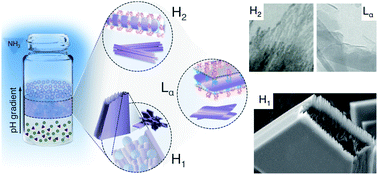Morphological control of calcium phosphate nanostructures using lyotropic liquid crystals†
Abstract
Organisms use “soft” organic compartments to control the morphology of the embedded “hard” minerals. Here we present a simple method using liquid crystal (LC) phases as “soft” and “inert” templates to prepare nanostructured calcium phosphates (CaPs), which are inorganics of known bioefficacy. Specifically, 6 nm-thick CaP nanowires and CaP sheets that precisely replicate reverse hexagonal (H2) and lamellar (Lα) LCs have been successfully synthesized and we attribute this to the sufficient spatial regulation offered by the negative (H2) or flat curvature (Lα) of the aqueous domain. A normal hexagonal (H1) phase possesses a positive curvature of the aqueous domain, therefore limited spatial restriction. For this reason, precise replication of the H1 phase by CaP has not been possible. Interestingly, the dynamic nature of the template allowed the construction of micron-sized brushite objects with a laminated structure decorating a specific facet, possibly as a result of epitaxial overgrowth of nano-sized brushite subunits.


 Please wait while we load your content...
Please wait while we load your content...